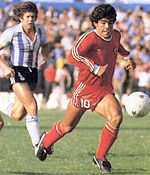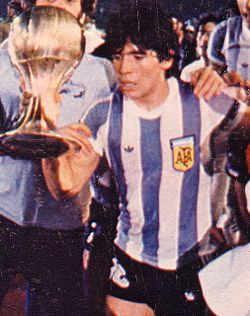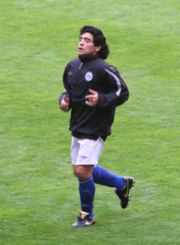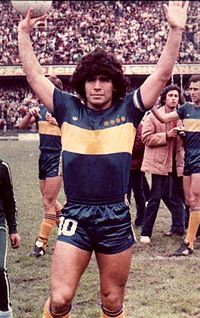Diego Maradona
2008/9 Schools Wikipedia Selection. Related subjects: Sports and games people
| Diego Maradona | ||
 |
||
| Personal information | ||
|---|---|---|
| Full name | Diego Armando Maradona | |
| Date of birth | October 30, 1960 | |
| Place of birth | Villa Fiorito, Buenos Aires, Argentina | |
| Height | 1.65 m (5 ft 5 in) | |
| Playing position | Supporting striker, Attacking Midfielder |
|
| Youth clubs | ||
| 1969-76 | Argentinos Juniors | |
| Senior clubs1 | ||
| Years | Club | App (Gls)* |
| 1976-1981 1981-1982 1982-1984 1984-1991 1992-1993 1993 1995-1997 |
Argentinos Juniors Boca Juniors Barcelona Napoli Sevilla Newell's Old Boys Boca Juniors Career |
166 (116) 40 (28) 58 (38) 259 (115) 29 (7) 7 (0) 31 (7) 590 (311) |
| National team | ||
| 1977-1994 | Argentina | 91 (34) |
| Teams managed | ||
| Mandiyú de Corrientes Racing Club de Avellaneda |
||
|
1 Senior club appearances and goals |
||
Diego Armando Maradona (born October 30, 1960) is a former Argentine football player. In 2000 Maradona shared the FIFA Player of the Century award with Pelé after finishing first in a FIFA internet poll on the best player of the 20th century.
Maradona won many trophies with Boca Juniors, FC Barcelona and SSC Napoli over the course of his career. During an international career that included 91 caps and 34 goals, he played in four FIFA World Cup tournaments, leading the Argentina national team to its victory over West Germany in 1986 World Cup, in which he collected the Golden Ball award as the tournament's best player. He scored both goals in the 2-1 victory over England in the quarter-final of the '86 tournament. The first goal was an unpenalized handball known as the " Hand of God", while the second goal was a spectacular 60-metre weave through six England players, commonly referred to as "The Goal of the Century"
He is also considered one of the sport's most controversial figures. Maradona was suspended for 15 months in 1991 after a failed doping test for cocaine in Italy, and then again for ephedrine during the 1994 World Cup in USA.
After retiring from playing on his 37th birthday in 1997, he suffered ill health and weight gain, hardly helped by ongoing cocaine abuse. However, a stomach stapling operation helped control his weight gain. Since overcoming his cocaine addiction, he has become a TV host in Argentina.
Early years
Diego Armando Maradona was born in Villa Fiorito, a shantytown on the southern outskirts of Buenos Aires, to a poor family that had moved from Corrientes Province. He was the first son after three daughters. He has two younger brothers, Hugo (el Turco) and Eduardo (Lalo), both of whom were also professional football players.
At age 11, Maradona was spotted by a talent scout while he was playing in his neighbourhood club Estrella Roja. He became a staple of Los Cebollitas (The Little Onions), the junior team of Buenos Aires's Argentinos Juniors. As a 12-year-old ball boy, he amused spectators by showing his wizardry with the ball during the halftime intermissions of first division games.
Playing style
Maradona had a compact physique and could withstand physical pressure well. His strong legs and low centre of gravity gave him an advantage in short sprints. His physical strengths were illustrated by his two goals against Belgium in the 1986 World Cup. Maradona was a strategist and a team player, as well as highly technical with the ball. He could manage himself effectively in limited spaces, and would attract defenders only to quickly dash out of the melee (as in the second 1986 goal against England), or give an assist to a free teammate. Being short, but strong, he could hold the ball long enough with a defender on his back to wait for a teammate making a run or to find a gap for a quick shot.
One of Maradona's trademark moves was dribbling full-speed as a left wing, and on reaching the opponent's goal line, delivering lethally accurate passes to his teammates. Another trademark was the Rabona, a reverse-cross pass shot behind the leg that holds all the weight. This maneuver led to several assists, such as the powerful cross for Ramón Díaz's header in the 1980 friendly against Switzerland. He was also a dangerous free kick taker.
Also see Argentine Football Creole Style
Club career
Maradona made his professional debut on October 20, 1976 ten days before his sixteenth birthday, with Argentinos Juniors. He played there between 1976 and 1981, before his £1m transfer to Boca Juniors. Joining the squad midway through the 1981 season, Maradona played through 1982, and secured his first league winners' medal.
After the 1982 World Cup, in June, Maradona was transferred to FC Barcelona in Spain for a then world record £5m. In 1983, under coach César Luis Menotti, Barcelona and Maradona won the Copa del Rey (Spain's annual national cup competition), beating Real Madrid. However, Maradona had a difficult tenure in Barcelona. First a bout with hepatitis, then an ill-timed tackle by Athletic Bilbao's Andoni Goikoetxea jeopardized his career, but Maradona's physical strength and willpower made it possible for him to be back on the pitch after only 14 weeks. It is believed that it was while playing for Barcelona that Maradona was introduced to cocaine, to which he would become addicted.
The Napoli era
Maradona got into frequent disputes with Barcelona's directors, especially club president Josep Lluís Nuñez. In 1984, he demanded a transfer out of Nou Camp. He subsequently went to Serie A and SSC Napoli for another record fee, £6.9m, and became an adored star among the club's fans, as he elevated the team to its most successful era. Napoli won their only Italian Championships (1986/87 and 1989/1990), a Coppa Italia (1987), a UEFA Cup (1989) and an Italian Supercup (1990). Napoli were also runners-up in the Italian Championship twice, in 1987/88 and 1988/89, as well as being runners-up in the Coppa Italia in 1988/89. Maradona was the top scorer in Serie A in 1987/88, but during his time in Naples he faced a scandal there regarding an illegitimate son; he was also the object of some suspicion over an alleged friendship with the Camorra.
Maradona left Napoli in 1992, after serving a 15-month ban for failing a drug test for cocaine. He played for Sevilla FC (1992-93), Newell's Old Boys (1993) and Boca Juniors (1995-97). He also attempted to work as a coach on two short stints, leading Mandiyú of Corrientes (1994) and Racing Club (1995), but without much success. He retired from football on October 30, 1997, his 37th birthday.
International career
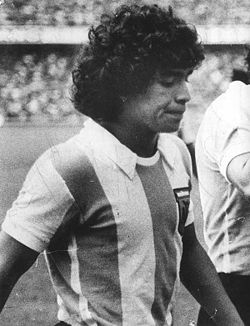
He debuted with the Argentina national football team, at age 16, against Hungary. At age 18, he played the Football World Youth Championship for Argentina, and was the star of the tournament, shining in their 3—1 final win over the USSR team.
1982 World Cup
Maradona played his first World Cup tournament in 1982. In the first round, Argentina, the defending champions, lost to Belgium. Although the team convincingly beat Hungary and El Salvador to progress to the second round, they were defeated in the second round by Brazil and by eventual winners Italy. Maradona played in all five matches without being substituted, scoring twice against Hungary, but was sent off with 5 minutes remaining in the game against Brazil for serious foul play.
1986 World Cup
Maradona captained the Argentine national team to victory in the 1986 FIFA World Cup, winning the final in Mexico against West Germany. Throughout the 1986 World Cup, Maradona asserted his dominance and was the most dynamic player of the tournament. He played every minute of every Argentina game, scored 5 goals and made 5 assists. However, it was the two goals he scored in a 2—1 quarter-final win against England which cemented his legend.
This particular match was played in the background of the Falklands war between those 2 very countries and emotions still were lingering in the air throughout the entire match. Replays showed that the first goal was scored by striking the ball with his hand. Maradona was coyly evasive, describing it as "a little with the head of Maradona and a little with the hand of God." The play became known as the " Hand of God," or "la mano de Dios." Ultimately, on 22 August 2005 Maradona acknowledged on his television show that he hit the ball with his hand purposely, and that he immediately knew the goal was illegitimate. However, the goal stood, much to the wrath of the England players. Maradona's second goal was to be later voted by FIFA as the greatest goal in the history of the World Cup. He picked up the ball in his own half and with 11 touches swiveled around and ran more than half the length of the field, dribbling past five English players: ( Glenn Hoddle, Peter Reid, Kenny Sansom, Terry Butcher, and Terry Fenwick) and goalkeeper Peter Shilton. This goal was voted the Goal of the Century in a 2002 online poll conducted by FIFA.
Maradona followed this with two more goals in the semifinal against Belgium, including another virtuoso dribbling display for the second goal. In the final, the opposing West German side attempted to contain him by double-marking, but he nevertheless found the space to give the final service to Jorge Burruchaga for the winning goal. Argentina beat West Germany 3-2 in front of 115,000 spectators at the Azteca stadium and Maradona lifted the World Cup trophy as the greatest player in the world after dominating the tournament in a way no other player had ever done before in the history of the World Cup.
In a tribute to him, the Azteca stadium authorities built a statue of him scoring the "goal of the century" and placed it at the entrance of the stadium.
1990 World Cup
Maradona captained Argentina again in the 1990 FIFA World Cup. An ankle injury affected his overall performance, and he was much less dominant than four years earlier. Argentina were almost eliminated in the first round, only qualifying in third position from their group.
In the round of 16 match against Brazil, Claudio Caniggia scored the only goal after being set up by Maradona.
In the quarter final, Argentina faced Yugoslavia, the match ending 0—0 after 120 minutes, and Argentina advancing on penalty kicks, despite Maradona missing one of the penalties in the shootout. The semifinal against the host nation Italy was also resolved on penalties after a 1—1 draw; this time, Maradona was successful with his effort. In the final, Argentina lost 1—0 to West Germany, the only goal being a penalty by Andreas Brehme in the 85th minute after a controversial foul on Rudi Voller.
1994 World Cup
At the 1994 FIFA World Cup Maradona played in two games, scoring one goal against Greece, before being sent home after failing a drug test for ephedrine doping. In his autobiography, Maradona argued that the test result was due to his personal trainer giving him the power drink Rip Fuel. His claim was that the U.S. version, unlike the Argentine one, contained the chemical and that, having run out of his Argentinian dosage, his trainer unwittingly bought the U.S. formula. FIFA subsequently expelled him from USA '94 and Argentina were subsequently eliminated in the second round. Maradona has also separately claimed that he had an agreement with FIFA, on which the organization reneged, to allow him to use the drug for weight loss before the competition in order to be able to play. According to Maradona, this was so that the World Cup would not lose prestige because of his absence. This allegation has never been proven.
Retirement and honours
In 2000, Maradona published his autobiography Yo Soy El Diego ("I am The Diego"), which became an instant bestseller in his home country. Two years later, Maradona donated the Cuban royalties of his book to "the Cuban people and Fidel."
FIFA conducted a fan poll on the Internet in 2000, to elect the Player of the Century. Maradona finished top of the poll with 53.6% of the vote. Subsequently, however, and contrary to the original announcement of how the award would be decided, FIFA appointed a "Football Family" committee of football experts that voted to award Pelé the title. Maradona protested at the change in procedure, and declared he would not attend the ceremony if Pelé replaced him. Eventually, two awards were made, one to each of the pair. Maradona accepted his prize, but left the ceremony without waiting to see Pelé receive his accolade.
In 2001, the Argentine Football Association (AFA) asked FIFA for authorization to retire the jersey number 10 for Maradona. FIFA did not grant the request, even though Argentine officials have maintained that FIFA hinted that it would.
Maradona has won other fan polls, including a 2002 FIFA poll in which his second goal against England was chosen as the best goal ever scored in a World Cup; he also won the most votes in a poll to determine the All-Time Ultimate World Cup Team.
Argentinos Juniors named its stadium after Maradona on December 26, 2003.
On 22 June 2005, it was announced that Maradona would return to Boca Juniors as a sports vice president in charge of managing the First Division roster (after a disappointing 2004–05 season, which coincided with Boca's centenary). His contract began 1 August 2005, and one of his first recommendations proved to be very effective: he was the one who decided to hire Alfio Basile as the new coach. With Maradona fostering a close relationship with the players, Boca went on to win the 2005 Apertura title, the 2006 Clausura title, the 2005 Copa Sudamericana and the 2005 Recopa Sudamericana.
On 15 August 2005, Maradona made his debut as host of a talk-variety show on Argentine television, La Noche del 10 ("The Night of the no. 10"). His main guest on opening night was Pelé; the two had a friendly chat, showing no signs of past differences. However, the show also included a cartoon villain with a clear physical resemblance to Pelé. In subsequent evenings, he led the ratings on all occasions but one. Most guests were drawn from the worlds of football and show business, including Zidane, Ronaldo and Hernán Crespo, but also included interviews with other notable personalities such as Fidel Castro and Mike Tyson.
On August 26, 2006, it was announced that Maradona was quitting his position in the club Boca Juniors because of disagreements with the AFA, who selected Basile to be the new coach of the Argentina National Football Team.
The award-winning Serbian filmmaker Emir Kusturica made a documentary about Maradona's life, entitled Maradona.
In September 2006, Maradona, in his famous blue and white number 10, was the captain for Argentina in a three-day World Cup of Indoor Football tournament in Spain.
In 2006, Diego Maradona was appointed as a Goodwill Ambassador of the Intergovernmental Institution for the use of Micro-algae Spirulina Against Malnutrition, IIMSAM.
Personal agents
Jorge Cyterszpiller, a childhood friend, was Maradona's first agent. He set up Maradona Producciones but did not score any major successes with merchandising, as counterfeiters would quickly imitate any product that came on the market. On his advice, Maradona started charging for interviews, a move that generated some controversy.
After breaking up with Cyterszpiller, Maradona hooked up with Guillermo Coppola, a bank employee who had started representing players as a hobby and was already a major agent in the mid-1980s. Coppola oversaw the biggest contracts of Maradona's career, but also was involved in the drug scandals of the early 1990s. Maradona and Coppola parted ways acrimoniously, and they still refer to the end of their relations as an "open wound".
Personal life
Maradona married long-time fiancée Claudia Villafañe on November 7, 1989 in Buenos Aires, after the birth of their daughters, Dalma Nerea (b. 1987) and Giannina Dinorah (b. 1989). In his autobiography, Maradona admits he was not always faithful to Claudia, even though he refers to her as the love of his life.
Maradona and Villafañe divorced in 2004. Daughter Dalma has since asserted that the divorce was the best solution for all, as her parents remained on friendly terms. They traveled together to Napoli for a series of homages in June 2005 and were seen together on many other occasions, including the Argentina matches during 2006 FIFA World Cup.
During the divorce proceedings, Maradona admitted he was the father of Diego Sinagra (b. Naples, 1986), as was claimed by the youth's mother Cristiana Sinagra. (The Italian courts had so ruled in 1993, after Maradona refused to undergo DNA tests for proving or disproving his paternity.) Diego Jr. met Maradona for the first time in May 2003 after tricking his way onto a golf course in Naples where Maradona was playing.
After the divorce, Claudia embarked on a career as a theatre producer, and Dalma is seeking an acting career; she has expressed her desire to attend the Actor's Studio in Los Angeles. Maradona has authored an autobiography entitled "Yo Soy El Diego" chronicling his life, both on and off the playing field. His autobiography was translated and published in English as Maradona: The Autobiography of Soccer's Greatest and Most Controversial Star. ( ISBN 1602390274)
Drug abuse and health situation
Since the 1990s, Maradona has had difficulties with cocaine abuse, which included spells in Swiss and Cuban detox clinics. Between 2002 and 2005, Maradona spent most of his time in Cuba.
On April 18, 2004, doctors reported that Maradona had suffered a major heart attack following a cocaine overdose; he was admitted to intensive care in a Buenos Aires hospital. Scores of fans gathered around the clinic. Days after the heart attack, a nurse was caught taking photos of Maradona with a mobile phone and was promptly fired by the hospital managers.
Fortunately he showed improvement and was taken off the respirator on April 23 and remained in intensive care for several days before being discharged on April 29. He returned to Cuba in May.
Maradona has always had a tendency to put on weight, and suffered increasingly with obesity from the end of his playing career until undergoing gastric bypass surgery in a clinic in Cartagena de Indias, Colombia on March 6, 2005. When Maradona resumed public appearances shortly thereafter, he displayed a notably thinner figure.
However, on March 29, 2007, Maradona was readmitted to a hospital in Buenos Aires. He was treated for hepatitis and effects of alcohol abuse, and was released on 11 April, but re-admitted two days later. In the following days there were constant rumors about his health, including three false claims of his death within a month. After transfer to a psychiatric clinic specialising in alcohol-related problems, he was discharged on May 7.
On May 8, 2007, Maradona appeared on Argentine television and stated that he has quit drinking and has not used drugs in two and a half years.
Political views
During the nineties, Diego Maradona supported the presidency of Carlos Menem in Argentina. In more recent years, Maradona has shown more sympathy to left-wing ideologies. He became friends with Fidel Castro while in treatment in Cuba. He has a portrait of Castro tattooed on his left leg and one of Ernesto "Che" Guevara on his right arm.
Maradona is also a supporter of Venezuelan President Hugo Chávez. In 2005 he visited Venezuela with the specific aim of meeting Chávez, who received him in Miraflores. After this meeting Maradona claimed that he had come with the aim of meeting a "great man" ("un grande" in Spanish) but he had met instead a gigantic man ("un gigante" in Spanish, meaning he was more than great).
"I believe in Chávez, I am Chavista. Everything Fidel does, everything Chávez does, for me is the best."
He has declared his opposition to imperialism, notably during the 2005 Summit of the Americas in Mar del Plata, Argentina. There he protested George W. Bush's presence in Argentina, wearing a T-shirt labeled "STOP BU卐H" and referring to Bush as "human garbage".
In August 2007, Maradona went further, making an appearance on Chávez's weekly television show and saying: "I hate everything that comes from the United States. I hate it with all my strength."
In December 2007, Maradona presented a signed shirt with a message of support to the people of Iran: it is to be displayed in the Iranian Ministry of Foreign Affairs' museum.
Reputation
Ever since 1986, it is common for Argentines abroad to hear Maradona's name as a token of recognition, even in remote places. In Argentina, Maradona is often talked about in terms reserved for legends. In the Argentine film El Hijo de la Novia ("The bride's son"), an actor who plays a fake Catholic priest says to a bar patron: "they idolized him and then crucified him". When scolded by a friend for taking the prank too far, the fake priest retorts: "But I was talking about Maradona".
In Rosario city, Argentina, fans organized the " Church of Maradona." Maradona's 43rd birthday in 2003 marked the start of the Year 43 D.D. - "Después de Diego" or After Diego - for its founding 200 members. Tens of thousands more have become members via the church's official web site.
Hounded for years by the press, Maradona even fired a compressed-air rifle against reporters who, so he claimed, invaded his privacy. This quote from former teammate Jorge Valdano summarizes the feelings of many:
| “ | He is someone many people want to emulate, a controversial figure, loved, hated, who stirs great upheaval, especially in Argentina... Stressing his personal life is a mistake. Maradona has no peers inside the pitch, but he has turned his life into a show, and is now living a personal ordeal that should not be imitated. | ” |
A television commercial for Brazilian soft drink Guaraná Antarctica portrayed Maradona as a member of the Brazilian national football team, including wearing the yellow jersey and singing the Brazilian national anthem with Brazilian caps Kaká and Ronaldo. Later on in the commercial he wakes up realizing it was nightmare after having drank too much of the soft drink. This generated some controversy in the Argentine media after its release (although the commercial was not supposed to air on the Argentine market, fans could see it via internet). Maradona replied that he has no problem in wearing the Brazilian national squad jersey, instead, only in wearing River Plate's jersey.
In May 2006, Maradona agreed to take part in UK's Soccer Aid (a program to raise money for Unicef). Maradona scored a penalty but it was too late to save the match which England won 2-1.
Career statistics
Club
- His overall average of goals scored per match in domestic club competitions is 0.53.
International
- Started in 21 consecutive matches for Argentina in four World Cups (1982, 1986, 1990, 1994)
- Appeared a World Cup-record 16 times as captain of the national team.
- Scored 8 goals and made 8 assists in 21 World Cup appearances, including 5 goals and 5 assists in 1986
- Tied for second-highest goal-scorer from Argentina in World Cup finals (equaled Guillermo Stabile's mark in 1994; surpassed by Gabriel Batistuta in 1998)
Statistics
| Club Performance | League | Cup | Continental | Total | ||||||
|---|---|---|---|---|---|---|---|---|---|---|
| Season | Club | League | Apps | Goals | Apps | Goals | Apps | Goals | Apps | Goals |
| Argentina | League | Cup | South America | Total | ||||||
| 1976 | Argentinos Juniors | Primera División | 11 | 2 | - | - | 11 | 2 | ||
| 1977 | 49 | 19 | - | - | 49 | 19 | ||||
| 1978 | 35 | 25 | - | - | 35 | 25 | ||||
| 1979 | 27 | 26 | - | - | 27 | 26 | ||||
| 1980 | 45 | 43 | - | - | 45 | 43 | ||||
| 1981 | Boca Juniors | Primera División | 40 | 28 | - | - | 40 | 28 | ||
| Spain | League | Copa del Rey | Europe | Total | ||||||
| 1982-83 | Barcelona | La Liga | 20 | 11 | 5 | 3 | 4 | 5 | 29 | 19 |
| 1983-84 | 16 | 11 | 4 | 1 | 3 | 3 | 23 | 15 | ||
| Italy | League | Coppa Italia | Europe | Total | ||||||
| 1984-85 | Napoli | Serie A | 30 | 14 | 6 | 3 | - | 36 | 17 | |
| 1985-86 | 29 | 11 | 2 | 2 | - | 31 | 13 | |||
| 1986-87 | 29 | 10 | 10 | 7 | 2 | 0 | 41 | 17 | ||
| 1987-88 | 28 | 15 | 9 | 6 | 2 | 0 | 39 | 21 | ||
| 1988-89 | 26 | 9 | 12 | 7 | 12 | 3 | 50 | 19 | ||
| 1989-90 | 28 | 16 | 3 | 2 | 5 | 0 | 36 | 18 | ||
| 1990-91 | 18 | 6 | 3 | 2 | 4 | 2 | 25 | 10 | ||
| Spain | League | Copa del Rey | Europe | Total | ||||||
| 1992-93 | Sevilla | La Liga | 26 | 5 | 3 | 3 | - | 29 | 8 | |
| Argentina | League | Cup | South America | Total | ||||||
| 1993-94 | Newell's Old Boys | Primera División | 7 | 0 | - | - | 7 | 0 | ||
| 1995-96 | Boca Juniors | Primera División | 11 | 3 | - | - | 11 | 3 | ||
| 1996-97 | 13 | 2 | - | - | 13 | 2 | ||||
| 1997-98 | 6 | 2 | - | - | 6 | 2 | ||||
| Total | Argentina | 240 | 150 | - | - | 240 | 150 | |||
| Spain | 62 | 27 | 12 | 7 | 7 | 8 | 81 | 42 | ||
| Italy | 188 | 81 | 54 | 29 | 25 | 5 | 267 | 115 | ||
| Career Total | 490 | 258 | 66 | 36 | 32 | 13 | 588 | 307 | ||
Honours
Club
 SSC Napoli
SSC Napoli- Serie A: 1987, 1990
- Coppa Italia: 1987
- Capocannoniere: 1988
- UEFA Cup: 1989
- Italian Super Cup: 1990
Country
 Argentina
Argentina- FIFA World Youth Championship: 1979
- FIFA World Cup:
- Winner: 1986
- Runner-up: 1990
- Artemio Franchi Trophy: 1993
- 75th anniversary FIFA Cup: 1979
Individual
- Golden Ball for Best Player of the FIFA U-20 World Cup: 1979
- Argentine league Top Scorer: 1979, 1980, 1981
- Argentine Football Writers' Footballer of the Year: 1979 — 1981, 1986
- South American Footballer of the Year (El Mundo, Caracas):1979, 1986, 1989, 1990, 1992
- Argentine Sports Writers' Sportsman of the Year: 1986
- Golden Ball for Best Player of the FIFA World Cup: 1986
- Best Footballer in the World (Once): 1986 — 1987
- World Player of the Year ( World Soccer Magazine): 1986
- Serie A Top Scorer: 1987/1988
- Golden Ball for services to football ( France Football): 1996
- Argentine Sports Writers' Sportsman of the Century: 1999
- "FIFA best football player of the century", people's choice: 2000
- "FIFA Goal of the Century" (1986 (2–1) v. England; second goal): 2002
- Argentine Senate "Domingo Faustino Sarmiento" recognition for lifetime achievement: 2005
Coaching career
- 1994 Mandiyú de Corrientes
- 1995 Racing Club de Avellaneda
